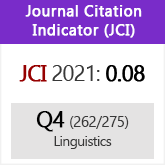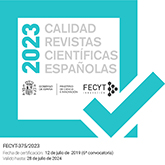Patterns of prominence, phrasing and tonal events in Spanish news reading: An illustrative case study
DOI:
https://doi.org/10.3989/loquens.2018.048Keywords:
intonational phonology, prominence, phrasing, tonal events, news readingAbstract
The present study examines the patterns in stress, phrasing and intonation found in a Spanish corpus of news read by broadcasters to describe the prosodic strategies that can be considered as genre-distinguishing features. Results indicate that, firstly, the main stress modifications concern the upgrading of unstressed syllables to accented ones, the stress shift to mark word-initial boundaries and the maintenance of adjacent stresses. Secondly, the special features related to phrasing are unexpected pauses, which enhance the prosodic units that offer new information, and the prosodic marking of initial edges of groups with the aim of capturing the listener’s attention. Finally, the most relevant tonal events that identify the typical chanting of broadcasters are a recurrent use of rises whose f0 peak coincides with the stressed syllable, a variety of non-falling pitch movements signalling intermediate phrasing, and the use of rising-falling pitch movements to signal ends. All the described prosodic and tonal strategies contribute to obtaining an emphatic style in news reading and are representative of a prosodically marked genre.
Downloads
References
Albelda Marco, M. (2005). Sistemas de transcripción de los corpus orales del espa-ol. In M. L. Carrió Pastor (Ed.), Perspectivas interdisciplinares de la lingüística aplicada, Vol. 2, 381–388.
Alcoba, S., & Murillo, J. (1998). Intonation in Spanish. In D. Hirst & A. Di Cristo (Eds.), Intonation Systems. A Survey of Twenty Languages (pp. 152–166). Cambridge: Cambridge University Press.
Arvaniti, A. (1994). Acoustic features of Greek rhythmic structure. Journal of Phonetics, 22, 239–268.
Beckman, M. E., & Ayers, G. (1997). Guidelines for ToBI labelling. The OSU Research Foundation, v. 3.
Beckman, M. E., Díaz-Campos, M., McGory, J. T., & Morgan, T. A. (2002). Intonation across Spanish, in the Tones and Break Indices framework. Probus, 14(1), 9–36. https://doi.org/10.1515/prbs.2002.008
Beckman, M. E., Hirschberg, J., & Shattuck-Hufnagel, S. (2005). The original ToBI system and the evolution of the ToBI framework. In S.-A. Jun (Ed.), Prosodic phonology: The phonology of intonation and phrasing (pp. 9–54). https://doi.org/10.1093/acprof:oso/9780199249633.003.0002
Bolinger, D. (1986). Intonation and its parts: Melody in spoken English. Stanford University Press. PMCid:PMC268683
Botinis, A., Granstrom, B., & Mobius, B. (2001). Developments and paradigms in intonation research. Speech Communication, 33(4), 263–296. https://doi.org/10.1016/S0167-6393(00)00060-1
Campione, E., & Veronis, J. (1998). Multext: A multilingual prosodic database. Proceedings of ICSLP 98, Vol. 7 (pp. 3163–3166).
Canellada, M. J., & Madsen, J. K. (1987). Pronunciación del espa-ol: Lengua hablada y literaria. Madrid: Castalia.
Cole, J. (2015). Prosody in context: A review. Language, Cognition, and Neuroscience, 30(1–2), 1–31. https://doi.org/10.1080/23273798.2014.963130
Cresti, E., & Moneglia, M. (2005). C-ORAL-ROM. Integrated reference corpora for spoken romance languages. John Benjamins Studies in Corpus Linguistics, 15. https://doi.org/10.1075/scl.15
de-la-Mota, C., & Rodero, E. (2011). La entonación en la información radiofónica. In A. Hidalgo Navarro, Y. Congosto Martín & M. Quilis Merín (Eds.), El estudio de la prosodia en Espa-a en el siglo XXI: Perspectivas y ámbitos (pp. 159–176). Facultat de Filologia, Traducció i Comunicació, Universitat de València.
Escudero, D., González, C., Gutiérrez, Y., & Rodero, E. (2017). Identifying characteristic prosodic patterns through the analysis of the information of Sp_ToBI label sequences. Computer Speech & Language, 45, 39–57. https://doi.org/10.1016/j.csl.2017.02.011
Escudero-Mancebo, D., Bonafonte, A., Aguilar, L., & Garrido, J. M. (2009). On the definition of a prosodically balanced corpus: Combining greedy algorithms with expert guided manipulation. Procesamiento del Lenguaje Natural, 43, 93–101.
Estebas Vilaplana, E. (2009). Cuatro niveles de altura tonal en la frontera de frase en espa-ol peninsular. Onomázein, 20, 11–32.
Estebas-Vilaplana, E., Gutiérrez, Y. M., Vizcaíno, F., & Cabrera, M. (2015) Boundary tones in Spanish declaratives: Modelling sustained pitch. In The Scottish Consortium for ICPhS 2015 (Ed.), Proceedings of the 18th International Congress of Phonetic Sciences. Glasgow, UK: The University of Glasgow, paper number 196, 1–4. Retrieved from https://www.internationalphoneticassociation.org/icphs-proceedings/ICPhS2015/Papers/ICPHS0196.pdf
Estebas-Vilaplana, E., & Prieto, P. (2010). Castilian Spanish intonation. In P. Prieto & P. Roseano (Eds.), Transcription of intonation of the Spanish language (pp. 17–48). Munich: LINCOM Europa.
Face, T. L. (2008). The Intonation of Castilian Spanish declaratives and absolute interrogatives. Muenchen: LINCOM Europa.
Face, T., & Prieto, P. (2007). Rising accents in Castilian Spanish: A revision of Sp_ToBI. Journal of Portuguese Linguistics, 5–6, 117–146. https://doi.org/10.5334/jpl.147
Farnetani, E., & Kori, E. (1983). Interaction of syntactic structure and rhythmical constraints on the realization of word prosody. Quaderni del Centro di Studio per le Ricerche di Fonetica (Padova), 2, 288–318.
Fernández Planas, A. M. (2005). Aspectos generales acerca del proyecto internacional "AMPER" en Espa-a. Estudios de Fonética Experimental, 14, 13–27.
Frota, S., D'Imperio, M., Elordieta, G., Prieto, P., & Vigário, M. (2007). The phonetics and phonology of intonational phrasing in Romance. In P. Prieto, J. Mascaró, & M.-J. Solé (Eds.), Segmental and prosodic issues in Romance phonology (pp. 131–153). Amsterdam: John Benjamins. https://doi.org/10.1075/cilt.282.10fro
Frota, S., & Prieto, P. (Eds.) (2015). Intonation in Romance. Oxford: Oxford University Press. https://doi.org/10.1093/acprof:oso/9780199685332.001.0001
Garrido, J. M., Escudero, D., Aguilar, L., Carde-oso, V., Rodero, E., de-La-Mota, C., . . . & Bonafonte, A. (2013). Glissando: A corpus for multidisciplinary prosodic studies in Spanish and Catalan. Language Resources and Evaluation, 47(4), 945–971. https://doi.org/10.1007/s10579-012-9213-0
Gutiérrez González, Y. M., & Aguilar, L. (2015). Nuevos datos empíricos sobre la entonación del espa-ol a partir del corpus de noticias Glissando. Estudios de Fonética Experimental, 24, 35–82.
House, J. (2006). Constructing a context with intonation. Journal of Pragmatics, 38(10), 1542–1558. https://doi.org/10.1016/j.pragma.2005.07.005
Hualde, J. I. (2002). Intonation in Spanish and the other Ibero-Romance languages: Overview and status quaestionis. In C. R. Wiltshire & J. Camps (Eds.), Romance phonology and variation: Selected papers from the 30th Linguistic Symposium on Romance Languages, Gainesville, Florida, February 2000 (pp. 101–116). Amsterdam: John Benjamins.
Hualde, J. I. (2007). Stress removal and stress addition in Spanish. Journal of Portuguese Linguistics, 6(1), 59–89. https://doi.org/10.5334/jpl.145
Hualde, J. I., & Prieto, P. (2015). Intonational variation in Spanish: European and American varieties. In S. Frota & P. Prieto (Eds.), Intonation in Romance (pp. 350–391). Oxford: Oxford University Press. https://doi.org/10.1093/acprof:oso/9780199685332.003.0010
Ladd, D. R. (2008) (2nd ed.). Intonational phonology. Cambridge: Cambridge University Press. https://doi.org/10.1017/CBO9780511808814
Liberman, M., & Prince, A. (1977). On stress and linguistic rhythm. Linguistic Inquiry, 8(2), 249–336.
Marín, R., Aguilar, L., & Casacuberta, D. (2002). Placing pauses in read spoken Spanish: A model and an algorithm. Language Design, 4, 49–66.
Navarro Tomás, T. (1925). Palabras sin acento. Revista de Filología Espa-ola, 12(4), 335–375.
Navarro Tomás, T. (1944). Manual de entonación espa-ola. New York: Hispanic Institute in the United States.
Nespor, M., & Vogel, I. (1994 [1986]) (Spanish trans.). Madrid: Visor.
Ortega-Llebaria, M., & Prieto, P. (2007). Disentangling stress from accent in Spanish: Production patterns of the stress contrast in deaccented syllables. In P. Prieto, J. Mascaró, & M.-J. Solé (Eds.), Segmental and prosodic issues in Romance phonology (pp. 155–197). Amsterdam: John Benjamins. https://doi.org/10.1075/cilt.282.11ort
Ortega-Llebaria, M., & Prieto, P. (2011). Acoustic correlates of stress in Central Catalan and Castilian Spanish. Language and Speech, 54(1), 73–97. https://doi.org/10.1177/0023830910388014 PMid:21524013
Pamies Bertrán, A., Fernández Planas, A. M., Martínez Celdrán, E., Ortega Escandell, A., & Amorós Céspedes, M. C. (2002). Umbrales tonales en espa-ol peninsular. In J. Díaz García (Ed.), Actas del II Congreso de Fonética Experimental (pp. 272–278). Sevilla: Universidad de Sevilla.
Penny, R. (2000). Variation and change in Spanish. Cambridge: Cambridge University Press. https://doi.org/10.1017/CBO9781139164566
Pierrehumbert, J., and Hirschberg, J. (1990). The meaning of intonational contours in the interpretation of discourse. In P. R. Cohen, J. Morgan, & M. E. Pollack (Eds.): Intentions in communication (pp. 271–312). Cambridge, MA: MIT Press.
Prieto, P. (2005). Stability effects in tonal clash contexts in Catalan. Journal of Phonetics, 33(2), 215–242. https://doi.org/10.1016/j.wocn.2004.07.001
Prieto, P., & Ortega-Llebaria, M. (2006). Stress and accent in Catalan and Spanish: Patterns of duration, vowel quality, overall intensity, and spectral balance. In R. Hoffmann & H. Mixdorf (Eds.), Proceedings of Speech Prosody 2006, Dresden, Germany (pp. 337–340).
Prieto, P. & Roseano, P. (Dirs.) (2009–2013). Atlas interactivo de la entonación del espa-ol. http://prosodia.upf.edu/atlasentonacion/
Prieto, P., & Roseano, P. (Eds.) (2010). Transcription of intonation of the Spanish language. Munich: LINCOM Europa.
Quilis, A. (1983). Frecuencia de los esquemas acentuales en espa-ol. In Estudios ofrecidos a Emilio Alarcos Llorach, Vol. 5 (pp. 113–126).
Quilis, A. (1993). Tratado de fonología y fonética espa-olas. Madrid: Gredos.
Rietveld, A. C. M., & Gussenhoven, C. (1985). On the relation between pitch excursion size and prominence. Journal of Phonetics, 13, 299–308.
Rodero Antón, E. (2013). Peculiar styles when narrating the news: The intonation of radio news bulletins. Estudios sobre el Mensaje Periodístico, 19(1), 519–532.
Sosa, J. M. (1999). La entonación del espa-ol: Su estructura fónica, variabilidad y dialectología. Barcelona: Cátedra.
Torreira, F., Simonet, M., & Hualde, J. I. (2014). Quasi-neutralization of stress contrasts in Spanish. In N. Campbell, D. Gibbon, & D. Hirst (Eds.), Proceedings of the 7th International Conference on Speech Prosody (Speech Prosody 7) (pp. 197–201).
Wagner, P., Origlia, A., Avesani, C., Christodoulides, G., Cutugno, F., D'Imperio, M., . . . & Vainio, M. (2015). Different parts of the same elephant: A roadmap to disentangle and connect different perspectives on prosodic prominence. In The Scottish Consortium for ICPhS 2015 (Ed.), Proceedings of the 18th International Congress of Phonetic Sciences. Glasgow, UK: The University of Glasgow, paper number 202, 1–5. Retrieved from https://www.internationalphoneticassociation.org/icphs-proceedings/ICPhS2015/Papers/ICPHS0202.pdf
Xu, Y., & Xu, C. X. (2005). Phonetic realization of focus in English declarative intonation. Journal of Phonetics, 33(2), 159–197. https://doi.org/10.1016/j.wocn.2004.11.001
Published
How to Cite
Issue
Section
License
Copyright (c) 2018 Consejo Superior de Investigaciones Científicas (CSIC)

This work is licensed under a Creative Commons Attribution 4.0 International License.
© CSIC. Manuscripts published in both the printed and online versions of this Journal are the property of Consejo Superior de Investigaciones Científicas, and quoting this source is a requirement for any partial or full reproduction.All contents of this electronic edition, except where otherwise noted, are distributed under a “Creative Commons Attribution 4.0 International” (CC BY 4.0) License. You may read here the basic information and the legal text of the license. The indication of the CC BY 4.0 License must be expressly stated in this way when necessary.
Self-archiving in repositories, personal webpages or similar, of any version other than the published by the Editor, is not allowed.















